Circuit explanation of Radio Controlled Clock
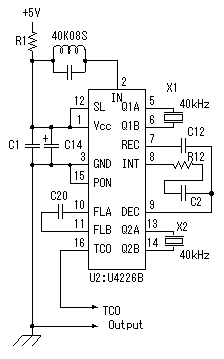 In the case of Japan, the radio of standard time is transmitted as long wave radio from the transmitting station in OOTAKADOYA mountain (40kHz) of Fukushima Prefecture, and HAGANE mountains (60kHz) of Nagasaki Prefecture. Reception of this radio is performed by U4226B. The parts attached outside are a receiving coil, 40kHz crystal oscillators, and some resistors and capacitors. U4226B is designed for radio-controlled clock applications in the frequency range of 40 to 80 kHz. Refer to the data sheet for detailed specification. 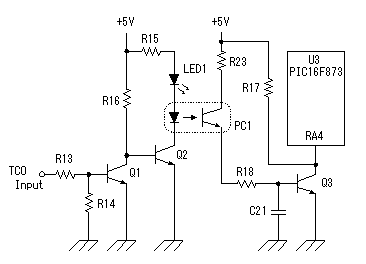 The output signal TCO( Time Code Output ) of U4226B is the pulse of 0V to 5V. This signal is amplified by the transistors in order to make sharp the rising edge and the falling edge of the pulse. LED1 is for the monitors of a TCO signal. The time information sent by radio consists of 60 pulses, and one pulse is sent in 1 second. Although the width of each pulse changes with information sent, blink of LED1 is performed for every second. Thereby, you can check whether radio has received normally. A receiver and a display processor can be installed in the place left by cable splicing. In this case, noise may be induced to a cable. The receiver circuit and the display processing circuit are electrically separated by the photo coupler (PC0) in order to lessen the influence. The capacitor C21 connected to the base of Q3 is for removing the noise induced to the cable. If the capacity of this capacitor is large, pulse shape will deteriorate. A TCO signal is inputted into RA4 port of PIC16F873. Unlike other ports, this port is an open drain type. That is, a pull-up (it pulls up to +5V) is not carried out inside PIC. Therefore, the pull-up is carried out by R17. 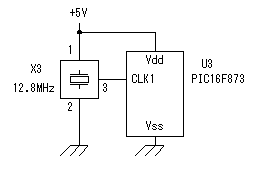 The time of this clock is displayed by the time information sent on radio. The right time cannot be displayed if radio stops. Therefore, the highly precise crystal oscillator is used for the clock of PIC. Oscillation frequency is 12.8MHz. The execution time of one step of PIC becomes 4/12.8 = 0.3124 microseconds. When radio is received normally, the accuracy of this oscillator does not become a problem. Two or more equipment, such as a cesium beam type atom frequency standard machine, is used for the Japanese standard clock. The accuracy is announced as 10-13. Since it is 31,536,000 seconds for one year, it is the accuracy that the error for 1 second will arise in 317,098 years. This system is not used so long. Therefore, this is the clock which does not go wrong at all. The time of this clock is displayed by the time information sent on radio. The right time cannot be displayed if radio stops. Therefore, the highly precise crystal oscillator is used for the clock of PIC. Oscillation frequency is 12.8MHz. The execution time of one step of PIC becomes 4/12.8 = 0.3124 microseconds. When radio is received normally, the accuracy of this oscillator does not become a problem. Two or more equipment, such as a cesium beam type atom frequency standard machine, is used for the Japanese standard clock. The accuracy is announced as 10-13. Since it is 31,536,000 seconds for one year, it is the accuracy that the error for 1 second will arise in 317,098 years. This system is not used so long. Therefore, this is the clock which does not go wrong at all.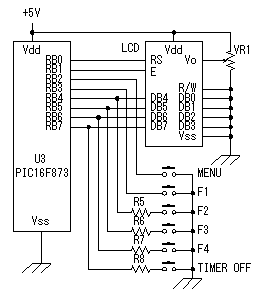 A time display, a timer setup, etc. are performed using a LCD display. SC1602BSLB used this time has the 8-bit mode and the 4-bit mode as data transfer mode. In this circuit, the 4-bit mode is used on account of the control port. RB port is used for the control port of PIC. In order to control in the 8-bit mode, it is needed also except RB port. RS (Register Select) is the terminal for a change of a command register (L) and a data register (H). E (Enable Signal) is a terminal for making information read into LCD. DB4-7 are the terminals for information transmissions. Moreover, the contrast of the character displayed on LCD can be adjusted by Vo. All the terminals that are not used are connected to grounding. SC1602BSLB has a back light function. There is an A/K terminal for back light power supplies in LCD. However, it is not necessary to connect a power supply here. They are connected inside LCD. A time display, a timer setup, etc. are performed using a LCD display. SC1602BSLB used this time has the 8-bit mode and the 4-bit mode as data transfer mode. In this circuit, the 4-bit mode is used on account of the control port. RB port is used for the control port of PIC. In order to control in the 8-bit mode, it is needed also except RB port. RS (Register Select) is the terminal for a change of a command register (L) and a data register (H). E (Enable Signal) is a terminal for making information read into LCD. DB4-7 are the terminals for information transmissions. Moreover, the contrast of the character displayed on LCD can be adjusted by Vo. All the terminals that are not used are connected to grounding. SC1602BSLB has a back light function. There is an A/K terminal for back light power supplies in LCD. However, it is not necessary to connect a power supply here. They are connected inside LCD.RB port serves also as the key input port of a timer setup (it is not a time setup). RB port is used if needed, changing to the input mode and the output mode. 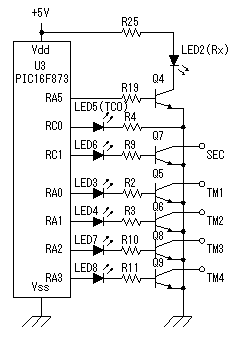 Lighting control of LEDs which display the operating state of this clock and the control circuit drive of external circuits are performed by RA port and RC port. I will explain below the feature of the circuit currently used by this kit. In the case of the circuit which is controlling LED2 (Rx), the consumed electric current of PIC can be lessened. The current which flows out of PIC is (5-0.6)V/10k-ohm = 0.00044A = 0.44mA. In the case of the circuit which is controlling LED5 (TCO), parts mark can be lessened. The circuit of SEC and TM1-4 is a circuit which displays a drive state by LED, driving an external circuit. The current which flows into LED is (5-2-0.6)V/470ohm = 0.0051A = 5.1mA. In the circuit of a kit, LED and an external drive circuit are not established in TM3 and TM4. I converted the circuit for True minute and True hour into the circuit for TM3 and TM4.  There are four timer functions in this radio clock. Four pieces of equipment is independently controllable, respectively. However, one piece of equipment is controlled by this equipment by four timers. A relay (RL1) is controlled by the circuit which connected the collector of Q5, Q6, Q8, and Q9 which are controlled by the timer function of PIC. Therefore, an external device is controllable at four time of the same day to be different. There are four timer functions in this radio clock. Four pieces of equipment is independently controllable, respectively. However, one piece of equipment is controlled by this equipment by four timers. A relay (RL1) is controlled by the circuit which connected the collector of Q5, Q6, Q8, and Q9 which are controlled by the timer function of PIC. Therefore, an external device is controllable at four time of the same day to be different.The operating state of a timer can be checked from that of LED which each relay drive circuit has. The power supply of a relay is connected to +12V(A) of a power circuit. Therefore, backup by capacitors is not performed at the time of AC input stop. When AC input stops, AC output to an external circuit is also suspended. It's not meaningful even if it backs up a relay.  The input voltage lowered to AC12V using the transformer is changed into a direct current on a diode bridge. 12V of AC12V are RMS(Root Mean Squared) value. Peak value is set to 16.8V the 1.4 times as many as this. Therefore, the output direct current voltage of a diode bridge is about 16V. This voltage is made into the voltage as for which 12V were stabilized in 3 terminal regulator. The purpose set to 12V is for the electric strength of a capacitor (C28-32). C28-32 are put for the backup at the time of AC input stopping. Electric Double Layer Capacitor is used for them. The maximum electric strength of the capacitor used this time is 2.5V. If these are connected to five-piece series, it will become the electric strength of 12.5V. In order not to exceed this voltage, 3 terminal regulator is used. The capacitance per one of C28-32 is 4.7F. When it connects with five-piece series, capacity is 1/5 ( 0.94F ). If it charges then, excessive current will flow into a power supply. R27 is put in order to prevent it. In this circuit, a 200-ohm resistor is used and the greatest charging current is 12V/200ohm=0.06A=60mA. It's not important although the charging time is long. The input voltage lowered to AC12V using the transformer is changed into a direct current on a diode bridge. 12V of AC12V are RMS(Root Mean Squared) value. Peak value is set to 16.8V the 1.4 times as many as this. Therefore, the output direct current voltage of a diode bridge is about 16V. This voltage is made into the voltage as for which 12V were stabilized in 3 terminal regulator. The purpose set to 12V is for the electric strength of a capacitor (C28-32). C28-32 are put for the backup at the time of AC input stopping. Electric Double Layer Capacitor is used for them. The maximum electric strength of the capacitor used this time is 2.5V. If these are connected to five-piece series, it will become the electric strength of 12.5V. In order not to exceed this voltage, 3 terminal regulator is used. The capacitance per one of C28-32 is 4.7F. When it connects with five-piece series, capacity is 1/5 ( 0.94F ). If it charges then, excessive current will flow into a power supply. R27 is put in order to prevent it. In this circuit, a 200-ohm resistor is used and the greatest charging current is 12V/200ohm=0.06A=60mA. It's not important although the charging time is long.D2 is for preventing the current from a capacitor flowing backwards at the time of AC input stop. D3 is for the charging current to a capacitor to pass along R27. The discharge current of a capacitor flows into load directly, without letting R27 pass by D3 at the time of an input stop. 12V backed up by the capacitor are supplied to CPU Unit and Rx Unit, and are changed into the voltage of 5V by 3 terminal regulator. Since a receiver circuit is connected by a cable, the choke coil is inserted in order to lessen influence of an external noise. |